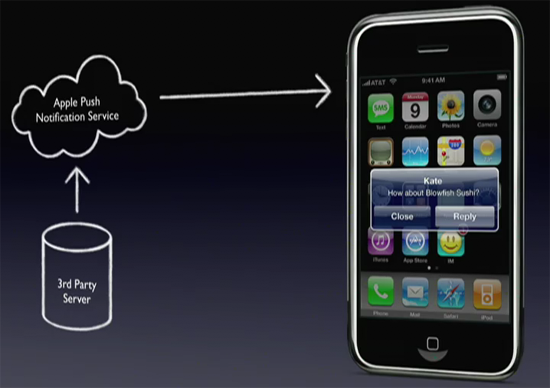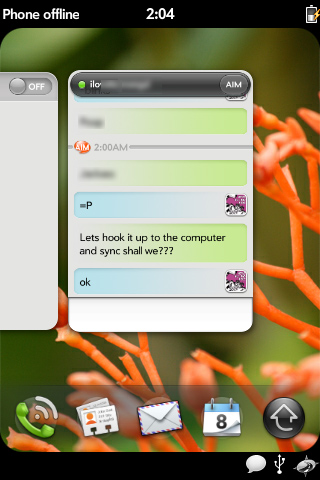Understanding the iPhone 3GS
by Anand Lal Shimpi on July 7, 2009 12:00 AM EST- Posted in
- Smartphones
- Mobile
The Inevitable Comparison: 3GS vs. Palm Pre
In response to my Pre review, many of you posted that the article read more like a comparison to the iPhone or a list of things for Apple to improve. I wrote it as such because I felt that while Palm out-innovated Apple in many ways, it fell short in just as many. At the same time I felt that Apple had much room to improve given the impact of the Pre, while also holding its advantages over the Pre. In short, neither device is perfect and both companies have much to learn from the other. It wouldn’t be fair for me to exclude the Pre from this article, as the iPhone 3GS delivers speed but lacks the functionality of what Palm has done with the Pre.
It’s a wonder what a year makes. Apple originally shied away from enabling background tasks on the iPhone because it didn’t want to compromise performance or battery life. The latter made sense, but the former didn’t really jive - the more we asked of the iPhone, the slower it got. In particular, its performance took a dive once the official App store launched along with the 2.0 firmware. Since then, the iPhone hasn’t exactly been fast - especially compared to some newer smartphones.
Apple’s solution to the background tasks problem was server-side push notifications. Take the most popular example: AIM. Since Apple doesn’t allow 3rd party applications to run in the background on the iPhone, if you’re in the middle of an AIM conversation and lock your phone, go to the home screen or launch another app, your connection to AIM is lost and your screen name logs off. You won’t get any new messages until you log back on.
 /
/
I love sushi
With the iPhone OS 3.0 the AIM app can use Apple’s push notification servers to keep the connection active. The minute you close the AIM app on the iPhone, the connection between your phone and AIM is severed but kept alive by one of Apple’s push servers. Any new messages that are to be delivered to your phone go to Apple’s servers, which know your phone’s IP and whereabouts. The servers then push the message to your phone and you see it like a SMS notification on the iPhone:
Sweet, right? It’s great for receiving a single message, but it’s horrible for actually maintaining a conversation. To respond to the message I have to click view message, then wait for the AIM app to launch and log me in and only then can I begin typing. Now let’s assume that I quit out of AIM because I had to do something else, or even worse, let’s assume that I left AIM because I had to send a text message. I’m now switching between two messaging apps to carry on two different conversations. It’s cumbersome.
As AIM messages pile up, the counter on my AIM app icon increments to let me know what I’ve got waiting for me.
Switching between apps is made much faster on the 3GS, this whole process is far more annoying on the 3G or original iPhone because actually launching the AIM app takes far longer. It’s a better overall experience but still no where near the seamless setup that Palm offers. If you mostly text/IM people on your phone, then honestly, forget the iPhone and get a Pre - Apple simply doesn’t do the best job here any longer.

Sending IMs and switching between apps on the Pre, the way it should be done
The iPhone OS needs a drastic revamp. The OS was designed very well for what the first iteration of the iPhone was created for: single tasking with SMS, email, web browsing, phone calls, music playback and browsing through photos. Add several pages of apps to the OS and try to multitask between them and the OS quickly shows its limits. Although Apple has added a very sweet Copy/Paste interface to the iPhone, that’s about the extent of how well you can work between apps thanks to Apple’s no background tasks limitation.
Palm got the implementation of a multitasking OS down right with the Pre, but the performance levels just aren’t up to snuff. Take using the dialer app for example. Animations are choppy and there’s a noticeable lag between when you tap a button and when the app responds. That just isn’t true of the iPhone and definitely not true of the 3GS; responsive is the key word here and Palm lacks it.
Unfortunately, what the 3GS has in responsiveness it lacks in productivity. The more I use the 3GS the more I wish I was able to run more than one application at a time. What I want is a phone that multitasks like webOS but with the speed of the 3GS. I believe that both Apple and Palm are capable of delivering such a device, I’m just unsure which company will do it first.










60 Comments
View All Comments
MrJim - Wednesday, July 8, 2009 - link
Why no mention of the heat issues?ViRGE - Wednesday, July 8, 2009 - link
Anand, if you haven't already, jailbreak the 3GS and grab SysInfoPlus from Cydia. It may be able to tell you the clock speed of the 3GS's ARM, although to what extent I'm not sure since it hasn't been specifically programmed for the A8.ltcommanderdata - Wednesday, July 8, 2009 - link
I don't suppose that program can also tell the GPU clock speed too?I always thought that the MBX work at bus speed, ie. 103MHz for the iPhone/3G and 133MHz for the 2nd Gen iPod Touch instead of the 60Mhz that Anand has speculated. Assuming the iPhone 3G S has a 150MHz bus speed, the SGX could run at 150MHz which is a reasonable compromise between Anand's 100MHz and 200MHz estimates.
fyleow - Wednesday, July 8, 2009 - link
How useful is the new GPU? The iPhone's performance has come a long way from the first generation but I don't see developers taking full advantage of the jump. If you bump up the graphics of your game it might run smoothly on the 3GS but end up lagging on the 1st gen iPhone.The increase in load times and battery life is much welcomed, but when do we get to see some apps that take advantage of the upgraded hardware in other more interesting ways? I can see a resolution increase as being one way to do that. The game would look better on a higher resolution screen but performance wouldn't suffer on the older models because the lower resolution would place less demand on the hardware.
2010 will be an interesting year. There should be a bigger upgrade to the iPhone, most likely a resolution bump and a significantly modified OS that supports background tasks. Apple has been keeping all the devices on the iPhone platform on feature parity so far with the OS upgrades (minus obvious limitations due to hardware differences). It would be interesting to see how they handle the switch and the resulting two classes of phones that come from it (i.e. old "legacy" iPhones/Touch vs new iPhones/Touch).
ltcommanderdata - Wednesday, July 8, 2009 - link
You're right that it's difficult to take full advantage of the SGX without writing a separate dedicated code path for it and one for the MBX. However, there are simpler ways to take advantage of the iPhone 3G S power without writing 2 separate code paths. For example, you can scale draw distance based on hardware. Firemint demonstrated the iPhone 3G S accelerating 40 cars in Real Racing compared to 6 in the iPhone 3G, so the potential for better scalable AI is there. For a RPG, perhaps having more NPCs walking around to make the environment more lifelike. This can all be done using existing OpenGL ES 1.1 code playable on all iPhones/Touches, optimizing for each device, without making older iPhone users feel like they are playing some Lite version of the game as implementing shaders and HDR using OpenGL ES 2.0 in the iPhone 3G S might do.I believe the reluctance of Apple to change the resolution is that it could break the interface layout for existing apps and/or make things ugly if apps haven't used vector graphics. It would have been nice if they had enforced resolution independence early on, but I don't believe they did. Resolution independence is also what is needed for Apple to introduce an iPhone nano with a smaller screen and presumably smaller resolution.
smallpot - Wednesday, July 8, 2009 - link
Thanks for the article Anand. Your long-form articles are the reason Anandtech is my number one tech website. I'm thinking of articles such as this, your articles on SSD performance, and the long-form story behind the RV770. After reading such articles, I really feel like I've learned something, rather than just had performance metrics thrown at me without context.Baron Fel - Tuesday, July 7, 2009 - link
Interesting article.As far as portable gaming goes, the Ipod Touch/iPhone/Zune HD dont have a chance against the DS or even the PSP. The software support just isnt there.
PSP hardware runs circles around the DS, so why is the DS killing it in sales? Good games.
and are we getting more SSD articles anytime soon? I think thats what we want to see :D
ltcommanderdata - Tuesday, July 7, 2009 - link
Given all the media attention about discoloration and possible heat issues with the iPhone 3G S, I was wondering if you could comment on your experience in this area. Do you think it's a real concern or just stories popularized to generate page hits as Apple related stories tend to do? The latest reports on discoloration indicate that it might actually be from a reaction with some third-party cases that may be reversed by cleaning with alcohol.Similarly, there have been lower-key reports of build quality issues with the Palm Pre having a wobbly screen from it's slide-out keyboard. Has this been a major issue for you and do you think it'll be an issue over time?
Anand Lal Shimpi - Tuesday, July 7, 2009 - link
I haven't seen anything to indicate heat as being a bigger concern with the 3GS. It's a new processor so there's bound to be some bad chips out there, but I wouldn't be too concerned.The build quality on the Pre did bother me. It's something that I think bothered me more because of my experience with the iPhone. The screen was a bit wobbly and overall the device just didn't feel as well put together. Part of it is because of the slide out keyboard, but part of it has to be cost/experience related. I think you'd get used to it over time, but if you then held an iPhone you'd quickly grow tired of the build quality issues once again :)
Take care,
Anand
tomoyo - Tuesday, July 7, 2009 - link
Btw Anand, the chart for number of stages in the cpus shows the Iphone 3GS as 8 stage instead of 13.